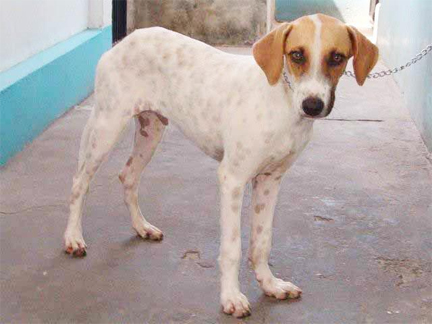Continued
Tonsillitis
Let us first understand what tonsils are.
You may have had a nail pierce your sole, and the result of that is a swelling in the inguinal area (the ‘groin’ as we call it). Now, that tissue that is swollen in the groin is similar to the tissue of the tonsils. (It is called lymphoid tissue.) So, just as an infection (the puncture wound) can cause the groin lymph tissue to swell up, so too can an infection cause the tonsils to become inflamed. Any inflammatory process involving the tonsils creates a tonsillitis. One sees a lot more cases of tonsillitis in dogs (especially the small breeds) than in cats.
 Where are the tonsils situated?
Where are the tonsils situated?
The tonsils can be found at the back of the throat and at the sides where the soft palate ends. In the dog (as in man) the tissue of the tonsils is compact. In the case of the dog, they are hidden in a fold. In fact, you can only see them if they are inflamed (when there is a tonsillitis).
Functions
As far as I can recall, there seems to be still great debate among scientists as to what the importance of the tonsils really is.
They appear to be concerned with the production of numbers of lymph cells which escape into the saliva and discharge some important function in connection with digestion (Black’s Veterinary Dictionary). In all probability, the tonsils represent a defence mechanism, protecting the animal from harmful bacteria and viruses, especially those that are ingested (taken in as the food particles enter the mouth).

Causes of tonsillitis
In most cases, tonsillitis will follow a nasal or oral (or pharynx) ailment. If there is an anatomical defect in the dog (eg, cleft palate), one may find a tonsillitis developing later on. Also, if the animal vomits constantly, tonsillitis could be a sequel. Constant coughing (bronchitis, heartworm disease, etc) can lead secondarily to a tonsillitis. Canine viral hepatitis is a good example of this type.
Those short-faced dogs (eg, Peki- nese, ‘Pompeks,’ etc) seem to be especially prone to bouts of tonsillitis, very likely associated with the respiratory distress such dogs experience in our type of climate (tropical).
All of these causes (examples) mentioned above are secondary in nature. In these instances, the tonsillitis followed a primary problem that already existed. However, there are cases in which the tonsils themselves, right at the beginning (primarily), become infected with bacteria (often E. coli, streps and staphs). Plant fibres (especially when dogs eat grass), or other foreign bodies could lodge themselves in tonsil tissue and create inflammation. Other physical (hot food) and chemical agents (licking off an insecticide from the skin) have been known to precipitate a tonsillitis. Finally (rarely), it has been documented that tonsillitis may accompany cancer-like growths which have developed in the tonsils, perhaps because of trauma or bacterial infection.
Next week, we’ll deal with the symptoms and treatment of tonsillitis.
Please implement disease preventative measures (vaccinations, routine dewormings, monthly anti-heartworm medication, etc) and adopt-a-pet from the GSPCA’s Animal Clinic and Shelter at Robb Street and Orange Walk, if you have the wherewithal to care well for the animals. Do not stray your unwanted pets, take them to the GSPCA’s Clinic and Shelter instead. If you do not wish your pet to have puppies or kittens, you may exploit the GSPCA’s free spay and neutering programme. If you see anyone being cruel to an animal, or if you need any technical information, please get in touch with the Clinic and Shelter by calling 226-4237.
